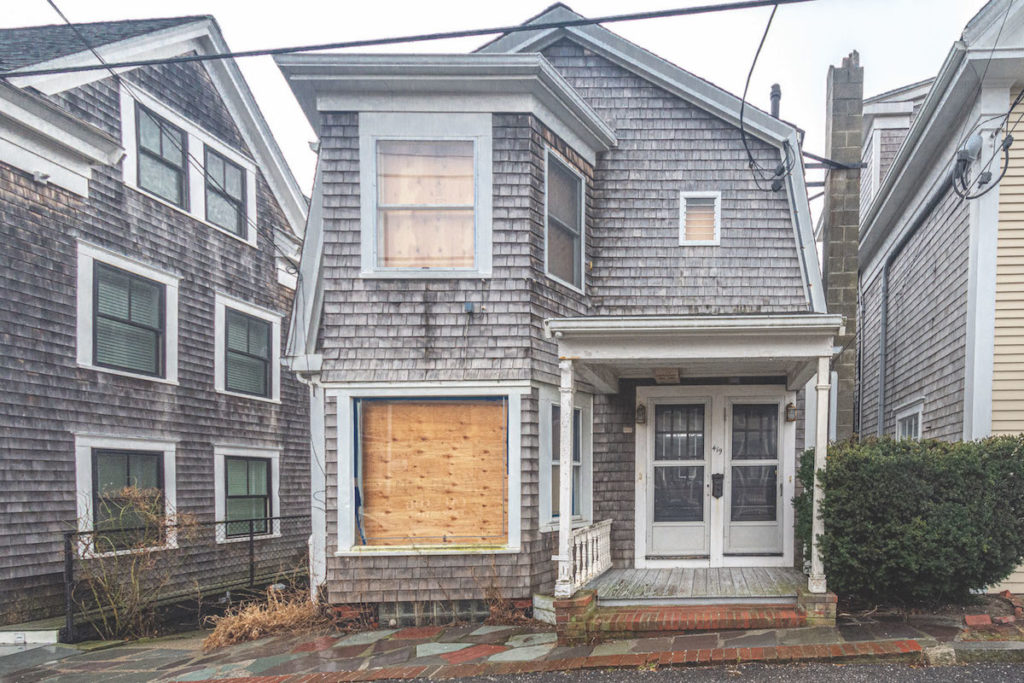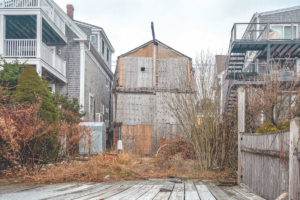
PROVINCETOWN — A 140-year-old cottage on Commercial Street overlooking the harbor won’t make it to its 141st birthday if the new owner is given the go-ahead to knock it down and replace it.
But that could be a tough sell.
Since the house is in the local historic district, developer Christine Barker, who bought the property at 419 Commercial St. for $1.6 million in November, cannot raze it without the approval of the Provincetown Historic District Commission.
Consultant Regina Binder was scheduled to give an informal presentation to the commission on Wednesday, Feb. 3 on behalf of Barker; a formal public hearing on the demolition request has been set for Feb. 17.
According to the bylaw regulating the historic district, partial or full demolition is prohibited, except when the commission concludes it is warranted “due to extraordinary circumstances.”
Unlike demolition delay bylaws, which enable town officials to stall the process so that alternatives can be explored, historic district commissions like Provincetown’s have the power to reject a demolition plan outright.

“It’s very rare to have a request to demolish an entire building in the historic district,” said commission chair Thomas Biggert. “There are times when we have to allow demolition, like when a building is unsafe. That usually happens when it’s an accessory building that’s substandard, like a chicken coop.”
Architectural historian David W. Dunlap, on his website Building Provincetown, describes 419 Commercial St. as having “a delightfully odd facade.” In 1949, Greenwich Village silversmith Paul A. Lobel expanded his business to Provincetown and set up his first local shop in the building, according to Dunlap’s account, and the antique store Ironmongers was there from 1978 to 1990.
More recently, the building was entirely residential, with the interior space divided into three units. After being owned by Laura Rust Egan (and Marguerite L. Young, until she died) for 44 years, the property changed hands three times in the last three years. The owner preceding Barker demolished a section at the rear of the building.
Barker initially submitted plans to the local permitting boards for a full renovation and addition off the back. The planned renovation would have accommodated two units. She also proposed boosting the structure 3.5 feet to address sea-level rise.
Her plans drew considerable opposition, expressed in emails submitted by those living nearby. The extension to the rear, they said, would block both view and airflow.
A week after filing those initial plans, Barker hired a structural engineer to look at the foundation. Lars Jensen, a principal at the Inghouse engineering firm, produced a report that recommended “the immediate and complete demolition of the existing building structure due to safety concerns.”
Supports throughout the building are inadequate, Jensen wrote. “The structure may collapse fully or partially under significant wind load or snow load events, which may lead to damage to adjacent buildings,” he stated.
Barker said she wasn’t happy to hear the structural engineer’s findings, noting, “This is not a demolition by choice.”
Plans to rebuild after demolition would reflect the cottage’s historic character, Barker said, replicating elements such as the gambrel roof, front porch, and bay window. “We will keep the Commercial Street side extremely appropriate, maintaining the dominant features,” she said. “It will be an improved version of itself.”
Although Barker is a real estate developer, she said that she doesn’t plan to “flip” the property but hopes to make it her future home.
Commission member John Dowd said he would not comment on a specific application that’s still pending. “If there are opponents to demolition of the building and virtual erasure of Provincetown history, they should make their voices heard at the meeting,” Dowd said.
“It’s not unusual that proponents, in concert with their contractor, make a play for demolition,” he added, speaking generally. “It’s much cheaper to tear down and rebuild. They always say it will be replicated, but you can’t replicate all the little things that tell that something is real. In the end, it basically still looks like a different building.”
Sarah Korjeff, historic preservation specialist and planner for the Cape Cod Commission, said Provincetown’s historic district covers “the vast majority” of the town’s historic properties. “There are 1,100 properties in it,” she said.
Properties in the district enjoy far greater protection than simple demolition delay bylaws provide, she said. “The demolition delay bylaw is definitely an important tool in preserving historic buildings, but there are still a lot of buildings lost,” Korjeff said. About 25 percent of the buildings that are subject to demolition delays are ultimately saved, but 75 percent are not.
Korjeff said demolition of a historic building, even if there are structural issues, is not the only solution. “There are a lot of cases where people claimed the building was unsalvageable, but it was just going to cost a lot to preserve it,” she said. “There are engineers out there who can find ways to preserve any historic building in any condition.
“My experience with Provincetown is that they are pretty good at doing their homework or requiring a second opinion,” Korjeff said. “Because it’s such a big district, they have a lot of experience.”
Other Outer Cape towns don’t have such far-reaching protections. Eastham has the small Olde Towne Centre Historic District, which is regulated by the town’s historic district commission.
Wellfleet has a larger National Register Historic District, including parts of Main Street and extending to the harbor, but the designation does not give the town the ability to stop demolition. The Cape Cod Commission can take action on demolition proposals of National Register properties that don’t have the protection of a local historic district.



